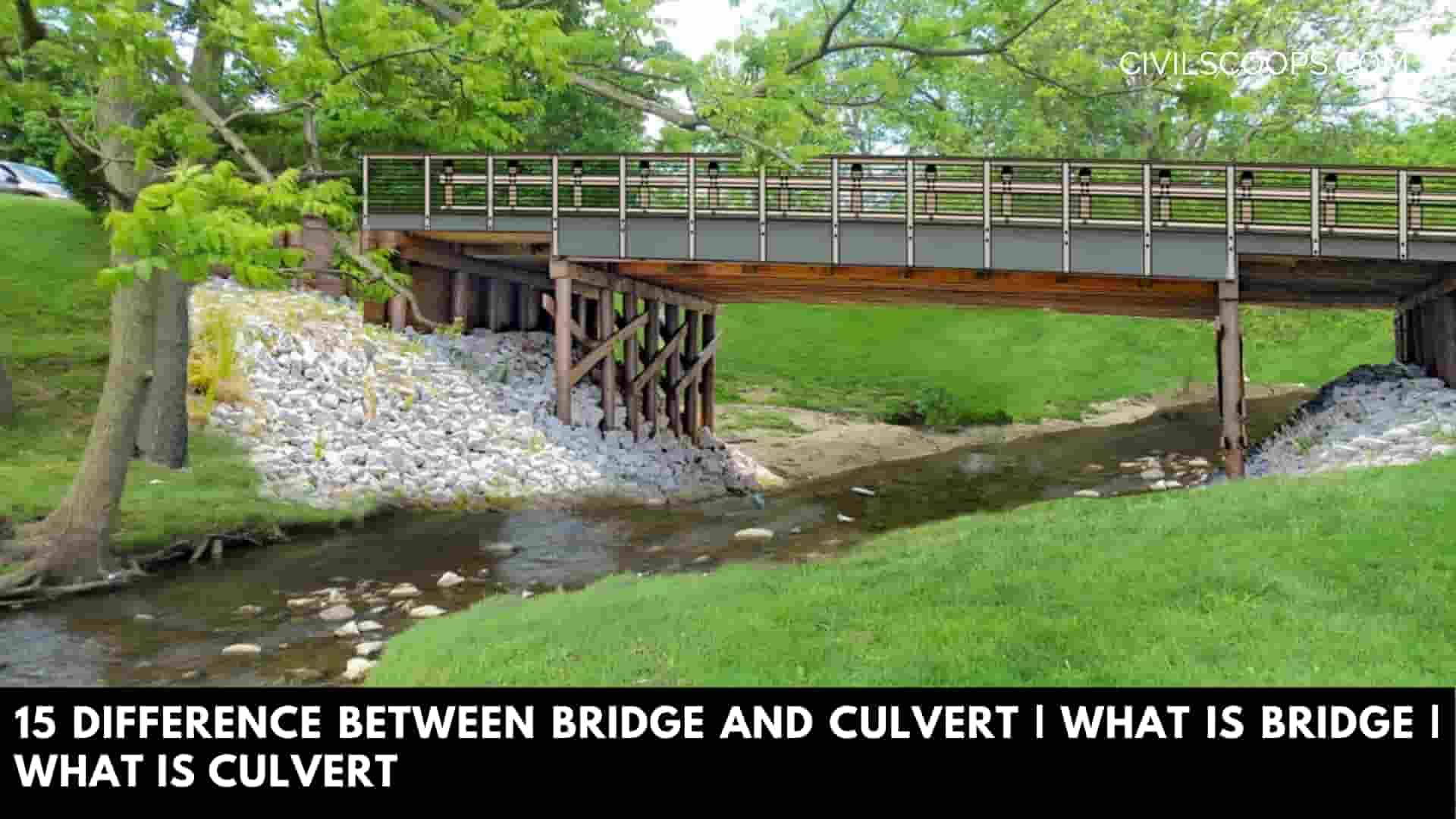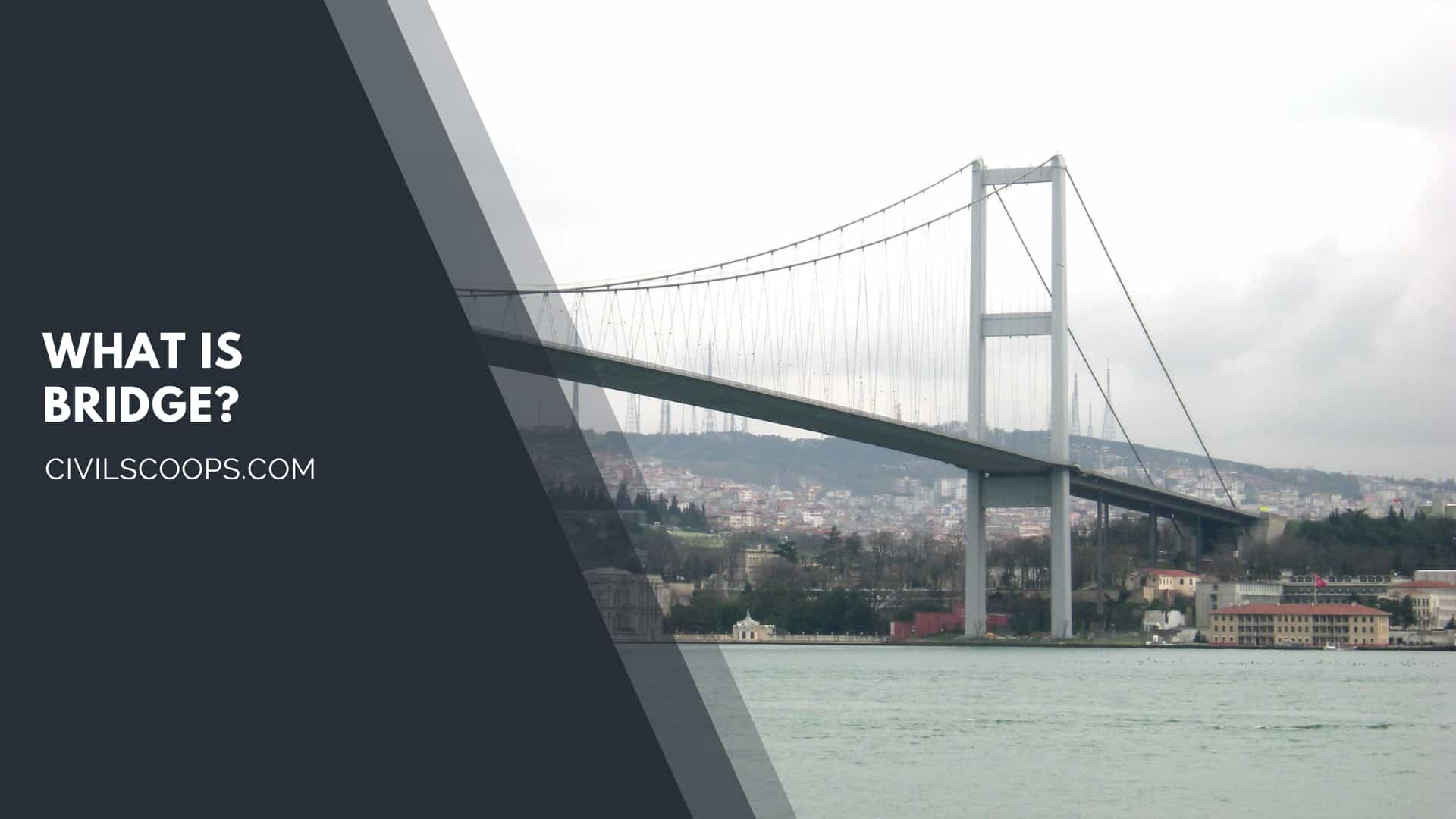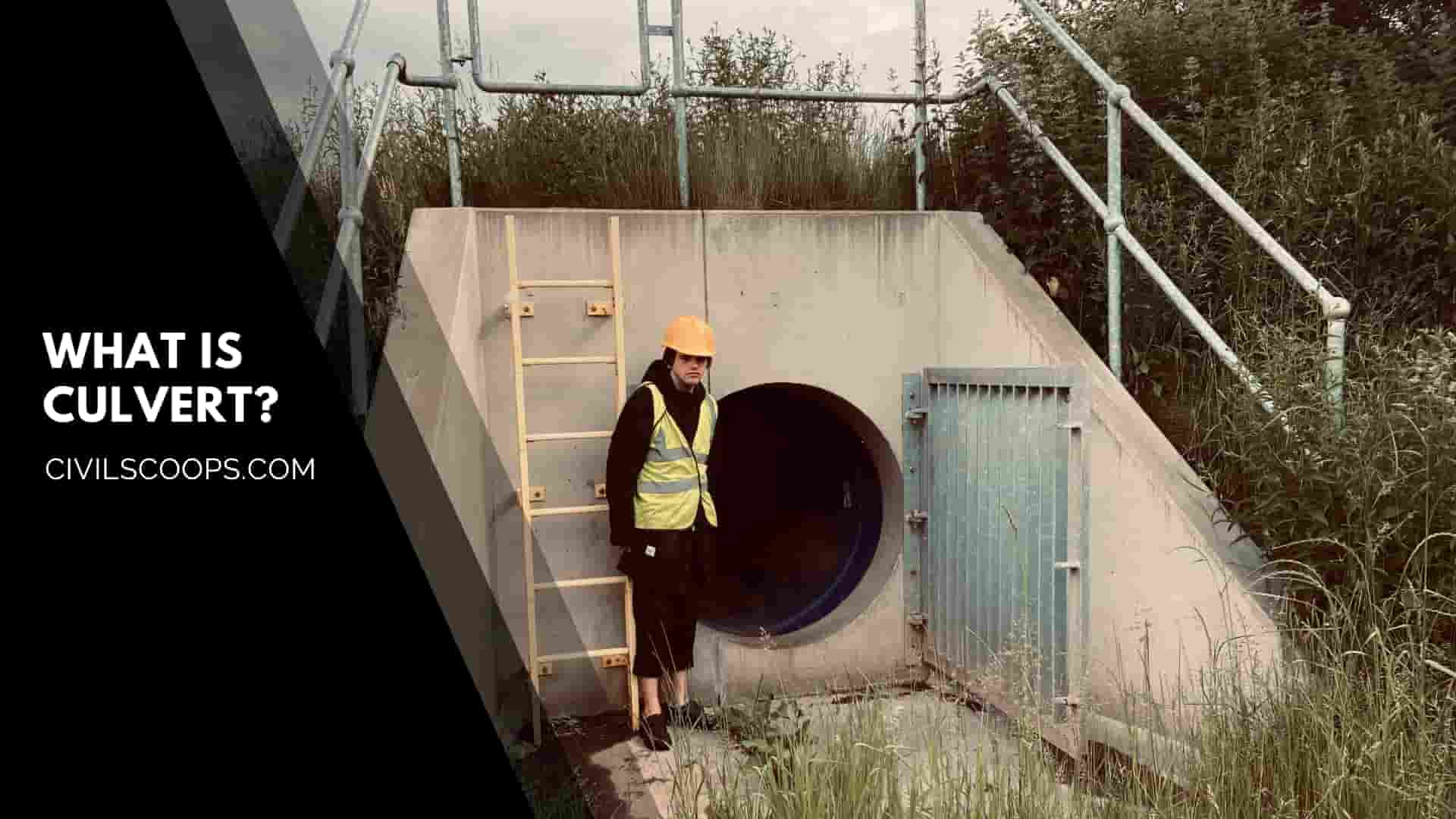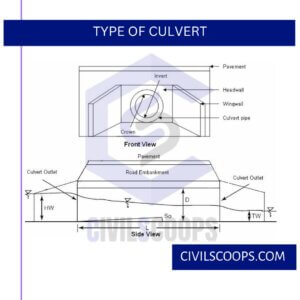15 Difference Between Bridge and Culvert | What Is Bridge | What Is Culvert

Table of Contents
What is Bridge?

A Bridge, a connecting structure, create bonding between different disconnected parts of a country, two banks of the ocean, or parts of two countries.
Information on Bridge
This first bridges made by humans were probably spans of planks or wooden logs and eventually stones, using a crossbeam arrangement and simple support. Most of these early bridges couldn’t support heavy weights or withstand strong currents.
It was these inadequacies that led to the development of better bridges. The oldest surviving stone bridge at China is the Zhaozhou Bridge, built from 605 to 595 AD during the Sui Dynasty.
The bridge is also historically significant as it is the world’s oldest open-spandrel stone segmental arch bridge
Type of Bridge
1. Classification of Bridges as Per According to Form
- Truss Bridge
- Arch Bridges
- Suspension Bridges
- Cable-Stayed Bridges
- Slab Bridges
- Box Girder Bridges
- Rigid Frame Bridges
2. Classification of Bridges as Per According to Material
- Composite bridge
- Steel bridge
- R.C.C bridge
- Stone bridge
- Concrete bridge
- Timber bridge
3. Classification of Bridges as Per According to Inter-Span
- Continuous bridge
- Simply supported bridge
- Cantilever bridge
Also Read: All About Sand | What Is Sand | 29 Types of Sand | Composition of Sand
What Is Culvert?

A Culvert is a tunnel carrying a stream under the road or railway. A culvert can act as a bridge for traffic to pass on it.
They are typically found at a natural flow of water and serves the purpose of a bridge or a current flow controller.
A culvert is provided under highways and roads for a crossing of water, as road embankment can’t be allowed to obstruct the water flow.
This culvert is ideally suited for a road to limit water flow at a controlled way. There are some common types of culvert, such as pipe, arch culvert, and box.
The culvert type is based onto hydraulic, water surface elevation, and roadway height, and other conditions.
Type of Culvert

- Pipe Single or Multiple
- Pipe Arch Single or Multiple
- Box Culvert Single or Multiple
- Bridge Culvert
- Arch Culvert
Difference Between Bridge and Culvert
| Sr.No. | Culvert | Bridge |
| 1 | These components of a culvert are comparatively simpler and include concrete boxes or cells, pipes, a top deck or slab, and supporting parts. | These basic components of a bridge( Parts of a bridge ) are superstructure, substructure, and deck (transfers surface load to other components). |
| 2 | The culvert is generally a tunnel-like structure that allows water to pass under a roadway or railway. | The bridge is a passage of transportation over a large body of water or physical obstruction. |
| 3 | These Culverts are usually embedded in the soil, which bears the major portion of the culvert load. | Abutments and Piers are the supporting structures of a bridge. |
| 4 | Culverts are totally enclosed structures that may be semi-circular, rectangular, elliptical or pear-shaped. | A bridge is usually straight and linear assage. |
| 5 | The culvert is an enveloping structure that consists of two sides, a roof, and a floor. | The bridge contains no floor. |
| 6 | The length of culverts is typically not more than 6 meters. | A bridge spans from 6 meters to more than 120 meters. |
| 7 | Not required a deep foundation in the culvert. | Construction of a deep and strong foundation is very important in building a bridge. A foundation along the entire breadth supports the bridge. |
| 8 | These Culverts are built at less than 20 feet high over the obstruction. | These Bridges are constructed at a height of more than 20 feet. |
| 9 | Culverts may be pre-constructed or built on the site. | Bridges are usually constructed in the site or pre-constructed in smaller parts. |
| 10 | The Culverts are simpler in structure and design, so it can be constructed with less time and labor. | The Construction of bridges generally requires a lot of time and manpower. |
| 11 | The construction of a culvert may be done with a low budget. | This structure and design of a bridge are elaborate and complex, hence its construction requires a substantial budget. |
| 12 | A culvert may be constructed to accommodate roadways both over and under the deck. | This only way of transportation is over the deck of the bridge. |
| 13 | Some culverts, like box culverts, have sharp corners that are unsuitable for high-velocity vehicles. | Bridges may withstand heavy and speeding vehicles. |
| 14 | A culvert is constructed when water needs to be conveyed through tunnels or channels under a roadway. | A bridge is built over a body of water that is large and has variable flow. |
| 15 | Culverts prevent waterlogging, flood, and erosion, and allows water to flow its natural course under a roadway or railway. | Bridges provide an easier route of transportation that saves time and reduces distance. |
[su_box title=”FAQ” style=”default” box_color=”#333333″ title_color=”#FFFFFF” radius=”3″ class=”” id=””]
Contract Bridge Rules
A bid contracts to win a specified number of odd tricks with a specified trump or at no trump. Thus, a bid of one heart assumes a contract to win seven tricks with hearts as trumps; a bid of one no trump, seven tricks with no trump suit. The highest possible bid is seven, a contract to win all 13 tricks.
American Contract Bridge Bidding Rules
Bids are composed of a number (1-7) and a suit (Notrump, ♠, ♥, ♦, ♣). Calls are Pass, Double and Redouble. Bids must be made according to the hierarchy of suits: clubs, diamonds, hearts, spades and finally notrump. If 1♣ is the opening bid, the next hand to bid must bid at least 1♦, the next hand at least 1♥ and so on.
Bridge Rules and Scoring
Points for each trick required and taken are scored as follows: 20 points in clubs and diamonds, 30 points in hearts and spades, 40 points for trick 7 in notrump and 30 points per trick over trick 7. These points are multiplied by two or quadrupled respectively if the contract has been doubled or redoubled.
Is Bridge Difficult to Learn?
It takes only rudimentary knowledge to begin playing and enjoying bridge, but be forewarned: this is not an easy game to learn, and it’s even more difficult (most say impossible) to master. But that’s precisely why bridge is so popular, and why it’s called “the game for a lifetime”.
What Is the Easiest Way to Learn Bridge?
A good place to start is by finding a local Bridge group or club, either in the senior living community or in the greater local area. Many Bridge clubs offer classes and are willing to help mentor new learners to help expand their organizations.
Brooklyn Bridge Information
The Brooklyn Bridge’s 486-metre (1,595-foot) main span was the longest in the world until the completion of the Firth of Forth cantilever bridge in Scotland in 1890. The towers are built of limestone, granite, and cement. Its deck, supported by four cables, carries both automobile and pedestrian traffic.
Truss Bridge
Truss bridges are characterized by the joining of numerous relatively small structural members into a series of interconnected triangles. They were first built of wood, then iron, then steel or occasionally a combination of the materials.
What Is the Main Purpose of a Bridge?
Bridges have a special place in transportation infrastructure due its direct relationship with other places. These structures have the purpose to carry on the traffic loads of the highway, crossing any obstacle and perform an effective communication between two destinations.
Who Made the First Bridge?
The ancient civilisations of Assyria and Egypt could have been the first to introduce bridge building. Stone arches can be found over the entrance of the great pyramid of Ghizeh, Egypt (3200 to 4200 BC) but they were not true arches as they were made of single sloping stones meeting over an opening.
What Makes Bridges So Strong?
Trusses help a bridge spread out the weight that it has to carry. But not all bridges are made of trusses. If a bridge has to cross a really wide body of water, it might be too difficult or expensive to build a truss bridge. So engineers designed another kind of bridge called a suspension bridge.
Beam Bridge
In its most basic form, a beam bridge consists of a horizontal beam that is supported at each end by piers. The weight of the beam pushes straight down on the piers. The beam itself must be strong so that it doesn’t bend under its own weight and the added weight of crossing traffic.
What Is the Strongest Type of Bridge?
Advantages of Truss Bridges
What Are the 3 Main Types of Bridges?
Three basic types of bridges used in transportation are: beam and truss bridges, arch bridges and suspension bridges.
Types of Culverts
Common types of culverts include round pipes, pipe arches, and box culverts, which may include multiple culverts or a combination of different sizes, types, and elevations at the same location.
Arch Culvert
An arch culvert is made up of metal, stone masonry, concrete, RCC etc. Construction does not take a lot of time and unlike box culvert, water diversion is not necessary, as it can be installed without disturbing the water current. Thus, it can be termed as a Low Profile Culvert.
What Is a Culvert Drain?
Culverts are a type of drainage pipe or channel built into roads, railroads, and bridges to give an opening underneath the surface for water to flow. Drainage ditches, often found on roadsides, provide a nearby, safe location for stormwater to go.
Culvert Definition in Civil Engineering
A culvert is a structure that channels water past an obstacle or to a subterranean waterway. Typically embedded so as to be surrounded by soil, a culvert may be made from a pipe, reinforced concrete or other material.
Road Culvert
Culverts are commonly used both as cross-drains to relieve drainage of ditches at the roadside, and to pass water under a road at natural drainage and stream crossings. When they are found beneath roads, they are frequently empty.
Culvert in Civil Engineering
A culvert is a structure that channels water past an obstacle or to a subterranean waterway. Typically embedded so as to be surrounded by soil, a culvert may be made from a pipe, reinforced concrete or other material. In the United Kingdom, the word can also be used for a longer artificially buried watercourse.
Culvert Material Types
Culverts are generally constructed out of concrete, galvanized steel, aluminum, or PVC. The pipe material used in a project depends on cost, span, discharge, topography, soil chemistry, climate or state policy.
Difference Between Bridge and Culvert
Culverts generally have short spans and are usually embedded in the soil. The culvert and the soil around it bear the weight of the roadway and the vehicles using it. A bridge has support structures beneath it, but between the supports are open areas, generally spanning more than 20 feet.
What Is Culvert Bridge?
Culvert is a buried structure, similar to bridges, consisting of single or multi-span construction with a minimum length of 3m for each span. Two horizontal slabs are cast monolithically with two or more vertical side walls, with a maximum span of 6m.
[/su_box]
[su_note note_color=”#F2F2F2 ” text_color=”#333333″ radius=”3″ class=”” id=””]
Like this post? Share it with your friends!
Suggested Read –
- 22 Types of Beams | Standard Size of Beams
- What Is Bridge | Components of Bridge and Their Function
- Plasticizer Vs Superplasticizer | What Is Plasticizer In Civil | What Is Superplasticizer In Civil
- What Is Honeycomb in Concrete | Cause of Honeycomb in Concrete| Cure of Honeycomb in Concrete | Types of Grouting
- Skeleton Frame | What Is Building Skeleton | What Is Steel Structure Building | Use of Steel Frame Structures| Advantages & Disadvantage of Steel Frame
[/su_note]
Originally posted 2023-02-25 11:11:07.
